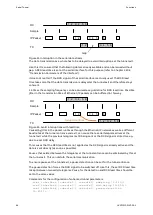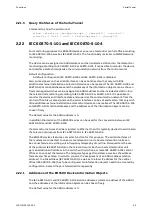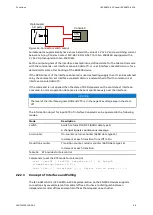
Functions
IEC 60870-5-101 and IEC 60870-5-104
For IEC 60870-5-104 a station is addressed with IP address and TCP port number. There are
no protocol specific addresses. TCP sets a point-to-point connection, polling mode does not
exist.
To test the correct operation of the communications link as well as the readiness for
operation of a station, there are test procedure for IEC 60870-5-101 (test function for the link
layer, link test) and IEC 60870-5-104 (test APDU, TESTFR, test frame). If errors occur then the
connection is terminated and re-established.
The definition of the ASDU is identical for both protocols and always has one identification
field of the data unit and one or more information objects.
The identification field of the data unit defines the type of the following information objects
(type id), a variable structure id (number of information objects in the ASDU), a transmission
cause and the shared address of the ASDU (station address).
For IEC 60870-5-104 the transmission cause may consist of alternatively one or two bytes. If
two bytes are used then the second byte has the meaning of an origin address.
IEC 60870-5-104 always uses two bytes, if the origin address is not known or not used then
the byte is set to null.
The station address can be one or two bytes long for IEC 60870-5-101 whereas IEC
60870-5-104 always uses two bytes.
The type id describes the structure of the contained information objects.
Typical information objects are:
•
Single point messages
•
Single point commands (one bit information),
•
Double point messages
•
Double point commands (two bis information),
•
Bit patterns,
•
Measurement data,
•
Counter values, a.m.m.
The information objects are defined differently with and without time stamp.
The supported type ids for IEC 60870-5-101 and IEC 60870-5-104 share a lot of ids but there
are type ids exclusively for IEC 60870-5-104 and in addition there are IEC 60870-5-101 ids that
are not valid any more for IEC 60870-5-104.
The differences can mainly be found in the representation of date formats and time formats.
IEC 60870-5-101 uses time stamps of the type CP24Time2a. CP24Time2a can show values of
up to an hour with a resolution of milliseconds.
IEC 60870-5-104 uses time stamps of the type CP56Time2a. CP56Time2a can show values of
up to 100 year with a resolution of milliseconds.
If central office and remote control devices operate strictly according to standard and use
and/or support only the defined types then the transmission format and the types have to be
converted.
The conversion of type ids is listed on the following pages in command direction as well as in
message direction. There is the option to switch conversion on or off.
If the conversion is switched on in message direction then there are two options in respect to
the extended time stamp for IEC 60870-5-104:
1KGT151021
V000 1
75
Содержание EDS500 Series
Страница 8: ...References Introduction 8 1KGT151021 V000 1 ...
Страница 152: ...Certificate Management Functions 152 1KGT151021 V000 1 ...
Страница 155: ...1KGT151021 V000 1 155 ...
















































